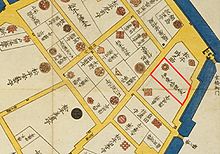Itō (clan)
The Itō ( Japanese 伊 東 氏 , Itō-shi ) were a family of the Japanese sword nobility ( Buke ), which was derived from Fujiwara no Korekimi (727-789) via Kudō Ietsugu . With an income of 36,000 Koku , the Itō , who last resided in Obi ( Hyūga Province ), belonged to the smaller Tozama daimyō of the Edo period .
genealogy
Kudō Ietsugu ( 工藤 家 次 ) had two sons, Sukeie ( 祐 家 ) and Suketsugu ( 祐 継 ).
Main line
- Sukechika ( 祐 親 ; † 1181/2), Sukuie's son, received the domain Kawazu ( Izu ) after the death of his father and was therefore also called Kawazu Jirō. His uncle Suketsugu fell ill and entrusted him to his son Suketsune, who should then receive it from the domain of Itō (Izu). But immediately after Sugetsugu's death, Sukechika sent his son away to Kyoto and took over his domain. Suketsune swore vengeance, and one day when the Minamoto no Yoritomo family accompanied them on the hunt, he killed Sukeyasu, Sukechika's son, and wounded Sukechika. This murder led to the revenge of the Soga brothers, the sons of Sukeyasu. Sukechika recovered from his injuries, but when he refused to follow Yoritomo on the campaign against the Taira , he was arrested and forced to commit seppuku.
- Sukekiyo ( 祐 清 ; † 1183), Sukechika's second son, went to Kyoto after the death of his father and joined the Taira. He was killed in the battle of Shinohara ( Ōmi ) while fighting against Kiso Yoshinaka .
- Suketsune ( 祐 経 ; † 1193), Suketsu's son, lost his domain to his uncle Itō Sukechika and was set in Kyoto. He retaliated by wounding his uncle Sukechika and killing his cousin Sukeyasu. The sons of Sukeyasu, the Soga brothers Sukenari (also Jūrō) and Tokimune (also Gorō) had to wait a long time for an opportunity for revenge. Eventually they were able to kill Suketsune in 1193 in the Yoritomo camp. They were caught and lost their lives themselves. The vengeance of the Soga brothers became an issue in Japanese literature, Nō , Kabuki, and Ukiyo-e .
- Yoshisuke ( 義 祐 ; 1512–1584), a descendant of Suketsune, inherited the domain Agata (also Nobeoka , Hyūga ) in 1533 . In 1541 he defeated the Shimazu , with the war going on for ten years. He was able to take Obi Castle from the Shimazu in 1568, but lost it again in 1572. In the siege of Takabaru in 1576 he lost to Shimazu Yoshihisa and a year later had his final defeat in the battle of Tozaki-Kamiya. He fled to Bungo and sought refuge in the residence of Atomo Sōrin . Eventually he went to Kyoto, where he died.
- Yoshimasu ( 義 益 ; 1546–1569), the eldest son of Yoshisuke, died before his father. His two sons, Yoshikata and Yoshikatsu were baptized in 1582 with the names Bartholomeus and Hieronymus.
- Suketaka ( 祐 兵 ; 1559–1600), another son of Yoshisuke, had been defeated with his father and fled with him in 1577 to the province of Bungo and then in 1579 to Kyoto. After Oda Nobunaga's death , he joined Toyotomi Hideyoshi , who appointed him Mimbu no taifu ( 民 部 大 輔 , "First Vice Minister of the Interior") and gave him areas in Kawachi Province . After the Kyūshū campaign in 1587, he received Obi Castle in Hyūga Province with 50,000 koku. Suketake also took part in the Korean campaign and received the title Bungo no kami in 1599 .
- Sukeyoshi ( 祐 慶 ; 1589–1636), a son of Suketaka, took part in the Battle of Sekigahara at the age of only eleven , then also in the campaign of Kuroda Yoshitaka and Katō Kiyomasa against the Shimazu . He received the title Shuri no daibu ( 修理 大夫 , "Director of Palace Repairs"), which his descendants also led. They resided in Obi until 1868.
Secondary branch
- A side branch, founded by Nagazane ( 長 実 ; 1560–1629), a descendant of Sukekiyos, resided from 1615 to 1868 in a permanent house ( jinya ) in Okada ( Bitchū ) with 10,000 koku.
Remarks
- ↑ Today a district of Nichinan .
- ↑ Sukeyasu's widow had married a Soga who adopted the sons.
- ↑ Today a district of Kurashiki .
Individual evidence
- ↑ Furusawa, Tsunetoshi: Kamon daichō . Kin'ensha, n.d., ISBN 4-321-31720-7 , p. 246.
- ↑ Excerpt from the map of the district "Soto-Sakurada" from approx. 1850.
- ↑ Excerpt from the "Surugadai" district map from around 1850.
literature
- Papinot, Edmond: Historical and Geographical Dictionary of Japan. Reprinted by Tuttle, 1972 edition of 1910 edition. ISBN 0-8048-0996-8 .
- Furusawa, Obi-jo: Kamon daichō . Kin'ensha, n.d., ISBN 4-321-31720-7 , p. 64.





